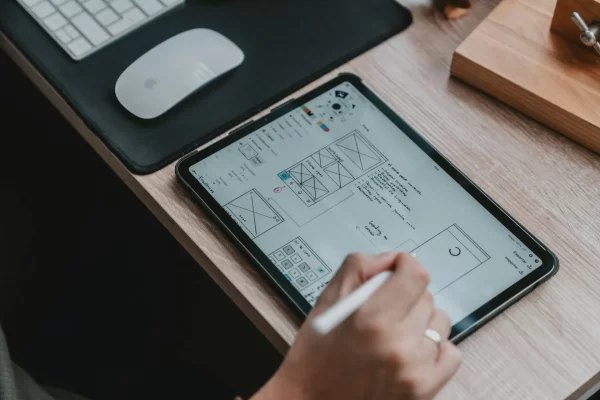When designing a website, it’s easy to focus on the content and forget about the space around it. But the way you use white space can have a big impact on the overall look and feel of your website. White space, also known as negative space, refers to the area between the elements on a page that is left blank. While it may seem like wasted space, using white space effectively can actually make your website look more elegant, professional, and easier to use.
In this blog post, we’ll explore how to use white space in web design to improve user experience. Before we dive into how to use white space effectively, let’s first discuss the basics of white space in web design.
Definition of White Space in Web Design
White space is the empty area between elements on a page, and it’s an important part of good web design. It can be any colour but is most commonly white, hence the name. White space can be used to create a sense of separation between different design elements or to emphasise certain parts of a design.
White space can be broken down into two categories: macro white space and micro white space.
Macro White Space
Macro white space refers to large areas of emptiness that are visible from across the page. It helps create a visual hierarchy by visually separating different sections of your content. This makes it easier for users’ eyes to move around the page without getting stuck on one thing for too long, and if they do get stuck, there’s plenty else going on in other parts of your site that they can look at instead.
Micro White Space
Micro white space refers to small gaps between individual elements like words or images. It helps guide users through dense content by creating clear divisions between paragraphs or sections within larger pages (like blog posts).
The Impact of White Space on User Experience
Using white space effectively can have a big impact on the user experience. Here are a few ways in which white space can improve the user experience:
- Makes the website easier to navigate: By creating space between design elements, you can make it easier for users to navigate your website. When there’s too much clutter on a page, it can be difficult for users to find what they’re looking for.
- Increases readability: White space can make the text easier to read by giving the eyes a break between lines and paragraphs. It can also help draw attention to the important text, such as headings or call-to-actions.
- Creates a sense of balance: White space can help create a sense of balance and proportion on the page, making the design more aesthetically pleasing and easier to look at.
The Relationship Between White Space and Visual Hierarchy
Visual hierarchy refers to the arrangement of elements on a page in a way that guides the user’s eye from one element to the next. White space plays a key role in the visual hierarchy by creating a sense of separation between different design elements.
For example, you can use white space to create a clear distinction between the header, navigation, and content sections of a web page. This helps guide the user’s eye from the top of the page to the bottom and makes it easier for them to find what they’re looking for.
How to Use White Space in Web Design?
Now that we’ve discussed the basics of white space in web design let’s talk about how to use white space effectively. Here are a few key principles to keep in mind:
Keep It Consistent
Consistency is key when it comes to using white space effectively. Make sure that you’re using the same amount of white space throughout your website and that you’re using the same spacing and padding for similar design elements. This will help create a sense of balance and make your website look more professional.
Use a Grid
Using a grid layout can help ensure that your white space is consistent and proportional. A grid can also guide the user’s eye from one element to the next, making your website look more organised. Overall, using a grid layout can help create a visually balanced and aesthetically pleasing design while improving your website’s user experience.
Think About Your Content
When designing your website, think about the content that will be on the page and how much white space it needs. For example, a page with a lot of text may need more micro white space to make it easier to read, while a page with many images may need more macro white space to make the images stand out.
Use White Space to Create Emphasis
You can use white space to draw attention to important elements on the page, such as headings, buttons, or calls to action. By creating more white space around these elements, you can make them stand out and increase the chances that users will interact with them.
Techniques for Creating White Space
Here are a few techniques you can use to create white space in your web design:
Margin and Padding
Margin and padding are two CSS properties to create white space around design elements. Margin creates space outside an element, while padding creates space inside an element. You can use these properties to create consistent and proportional white space, helping to create a polished and professional look for your website.
Line Spacing and Leading
Line spacing and leading refer to the space between lines of text. Increasing the line spacing or leading can create more micro white space and make the text easier to read. Adjusting these elements allows you to create a comfortable reading experience that encourages users to engage with your content.
Grid Layouts
You can use grid layouts to create consistent and proportional white space throughout a design. You can use a grid system such as Bootstrap or Foundation to create a grid layout for your website. Using a grid layout can also make it easier to align design elements and create a more structured and organised design.
Common Mistakes to Avoid When Using White Space
While white space can be a powerful tool in web design, there are also several common mistakes that designers can make when using it.
Here are some mistakes to avoid when incorporating white space into your web design:
- Not using enough white space: One of the most common mistakes in using white space is not using enough of it. When designers try to fit too much content into a small space, they can create a cluttered and confusing design that overwhelms the user. Giving enough breathing room between design elements can make your website easier to read and navigate.
- Using inconsistent amounts of white space: Another mistake is using inconsistent amounts of white space throughout your design. This can create a sense of imbalance and confusion for the user. To maintain a consistent and visually appealing design, use the same amount of white space between similar design elements.
- Not considering the content on the page: Another mistake is not considering the amount and type of content on the page when deciding on the amount of white space to use. A page with a lot of text may need more micro white space to make it easier to read, while a page with a lot of images may need more macro white space to make the images stand out.
- Cluttering the white space with unnecessary elements: Using too many design elements in the white space can make it look cluttered and overwhelming. Be intentional about what elements you include, and use white space to give each element room to breathe.
- Focusing too much on the white space: While white space is important, it’s not the only factor in a great design. Focusing too much on the white space can distract from other important design elements such as colour, typography, and imagery.
By avoiding these common mistakes, you can use white space effectively in your web design to create a clean, balanced, and user-friendly experience.
Start Using White Space in Your Web Design Today!
White space is a valuable tool in web design that can greatly impact your website’s user experience. By creating space between design elements, using white space to draw attention to important elements, and thinking about the content on the page when designing your website, you can create a website with a great user experience. So don’t be afraid to experiment with white space in your designs and see how it can take your website to the next level.
If you’re looking for a reliable and experienced digital web design agency to help your business grow, look no further than Digital Rescue. Contact us today to learn more about our services and how we can help you reach your goals. Let us be your digital rescue!



